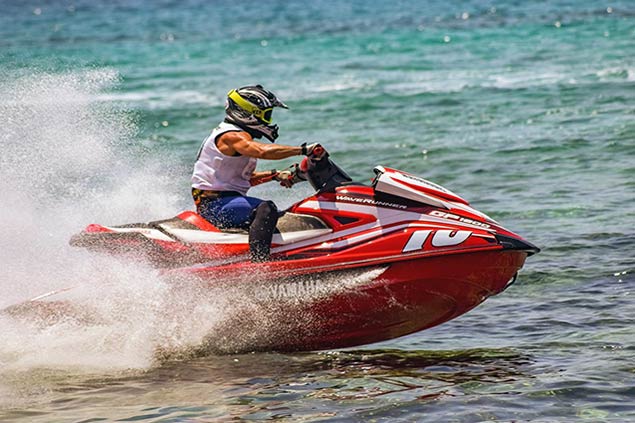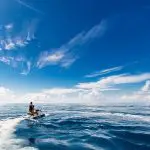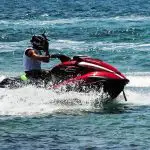Yamaha’s WaveRunner FZR, produced from 2009 to 2016, remains one of the finest muscleboats ever built.
Light on frills but heavy with performance, the FZR was billed as “ready to race” by Yamaha’s marketing department and there’s nothing false about the claim.

What’s the difference between Yamaha FZR and FZS?
Let’s dive in!
Contents
Overview of the FZ Series
Yamaha’s FZ series debuted for the 2009 model year, and was designed for riders who yearned for performance. In fact, Yamaha said that the FZ was the first sit-down PWC made for riding while standing, backing that claim with a three-way adjustable telescopic steering column to allow riders to go from sitting to standing with ease.
Some riders set the handlebar at its lowest setting to pull themselves closer to the water for aggressive cornering. Most left it in the middle for cruising comfort. Personally, I loved the highest setting as I tend to ride standing up nearly all the time and had often fitted taller handlebars to my own boats.
Underneath, the hull was shorter – in a way – and shaped to allow for far more aggressive cornering than the other WaveRunners of the time. It was essentially intended to take the vacant spot left in the line with the demise of Yamaha’s excellent two-stroke GP1300. Before the introduction of the newer incarnation GP1800 four-stroke machine in 2017, the FZ series was Yamaha’s flagship performance vehicle for the water.
Taking its inspiration from the GP1300, the dihedral keel shape was designed to allow for lean-in turning, and included an outside chine angled as such. (On an airplane, dihedral refers to the upward angle of the aircraft’s wings. Without launching into a lengthy explanation, let’s just say that the same angles as applied to a personal watercraft hull mean that the shape is used to bring the boat more quickly to the plane.) With the inclusion of the lifting strakes on either side, the FZR fairly leaps out of the water and onto its surface immediately, aiding acceleration.
The hull also allows the boat to stick like glue when ridden aggressively. The layout of the chines coupled with aggressively large sponsons allow an FZR rider to corner like a demon.
Features of Yamaha FZR and FZS
The FZ measured in at 132.7 inches in overall length, with a width of 48.4 inches. This was essentially the same size as Yamaha’s other flagship, the more comfort-oriented FX, but the design of the hull meant it that on the plane, it had a considerably shorter running surface in the water.
From the onset, the FZR and FZS models were equipped with Yamaha’s then most powerful watercraft engine, the 1812cc Super High Output powerplant with forced air induction through an intercooled supercharger.
Its 180-plus horsepower (probably more than 200, but Yamaha had adopted the policy of not announcing horsepower ratings by this point) was forced through a 155mm jet pump, with water intake coming via a performance-style scoop grate and being pushed by a variable pitch stainless steel impeller.
As this was intended as a pure performance machine, Yamaha largely left the bells and whistles out. This was a time when most manufacturers were pushing glitzy multi-function LCD dashboards, but Yamaha instead fitted the FZ line with large and easy to read twin analog dials giving a rider all the information he needs – speed and engine revolutions.
The trim system remained manual, and brutally effective. No slow-reacting electronics, but rather a simple mechanical twist system located at the left handlebar that, while sometimes difficult to turn with the machine pumping prodigious amounts of water through the high performance pump, was instantaneous in its deployment if you had the grip strength.
No cruise control because the FZ wasn’t made for cruising. No no-wake mode, because it was very definitely made for making waves.
Conversely, this was one of the first WaveRunners to abandon a conventional cable set-up for Yamaha’s then-current electronic throttle, which may have contributed to the awe-inspiring response.
The FZ series also included Yamaha’s key-fob type remote that could be used to disable the craft when parked, or serve as a learning curve nanny for newcomers by lowering the power output.
The original incarnation of the FZR weighed in at 807 pounds. The three-seater FZS tipped the scales at 813 pounds.
What is the difference between the FZR and FZS WaveRunner?
Not much. Yamaha didn’t fiddle around with a great design in increasing the passenger capacity. It does of course have a larger seat, and a grab bar to make boarding easier. It also was delivered standard with a tow eye for skiers, wakeboarders, or tow toys. Oh… and a spring-loaded boarding ladder.
And that’s it. A six-pound weight penalty isn’t much different in the grand scheme of what you’ve been eating for lunch lately, after all.
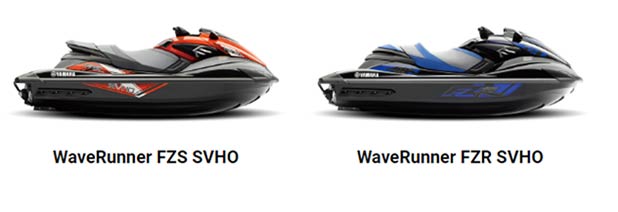
Changes along the way
Yamaha revised the FZR seat in 2012 to provide more of a bolster for the rider, giving a slightly more secure feeling when cornering while seated. I barely noticed, but some thought it was a big deal.
A much bigger deal was changed to the powerplant for the 2014 model year. Although ostensibly the same design, Yamaha claimed it has upgraded nearly every part in the now “Super Vortex” High Output motor, replacing the mere “Super High” Output engine. Most notably a new supercharger with an allegedly 25 percent more effective intercooler was fitted. The fuel injectors were larger, and the size of the oil cooler was increased.
Yamaha still wouldn’t put a number on horsepower output, but the company didn’t seem to have any reticence about claiming that the SVHO delivered 20 percent more power from a 60 percent greater boost – that seems like a stretch, honestly, but I don’t know – and boasted that whatever the horsepower number was, it was five percent more than the horsepower of Sea-Doo’s RXP-X, rated at 260 ponies.
Seems like a fairly specific number to put out there when you could just rate the horsepower like any other manufacturer, but that’s what Yamaha inexplicably did for quite a while.
Yamaha also bumped the size of the eight-vane jet pump 5 mil, from 155 to 160mm, extended the length of the ride plate, and swapped out the intake grate for a more race-inspired “scoop” style to better feed said pump.
Another fairly significant deal happened when the boat dropped 35 pounds from its original incarnation in 2015 when Yamaha changed the hull material to its second generation NanoXcel 2 composite.
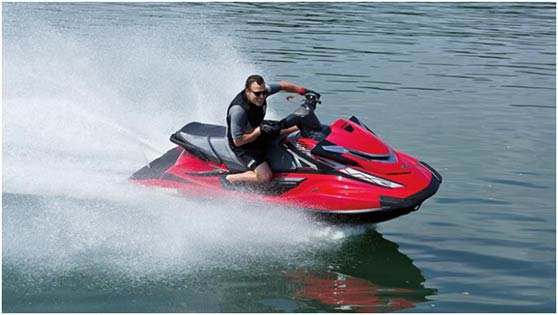
The result was a boat that would accelerate from 0 to 30 mph in something like 1.5 seconds before busting to a top speed of 67 mph or more. To this day, it remains one of the fastest personal watercraft ever sold with prodigious arm-stretching acceleration.
Yamaha also moved its aggressive race-inspired sponsons just a touch farther back. The difference was subtle, but most felt that the change did make the boat handle even more quickly and aggressively than it had previously. Which was saying something.
And that was it. The FZR was discontinued in 2017, with Yamaha essentially replacing it in the lineup with the rebirth of the much loved GP series. The GP1800R would weigh in lighter, and offer a bit of a horsepower upgrade. But if you’re still riding your FZR, you know you aren’t giving up much performance to anyone, anywhere, even still.
Horses for courses. I like fast horses!
Much like Yamaha’s current GP1800, the FZR wasn’t for everyone. They accelerated hard, cornered hard, and begged for an athletic approach to their operation that would leave shoulders and legs burning with oxygen after a good hard ride.
Writing about the history of Yamaha’s GP series a few weeks back really put me in a mood to relive a portion of my misspent youth by locating a two-stroke GP1300R that’s enough there to resuscitate with some tender loving care. But if I were to stumble across a Yamaha FZR in good nick, I’d certainly have to consider that as well. Truly a marvelous muscleboat, with a magnificent handling package.
Rating: Recommended. Highly recommended.
